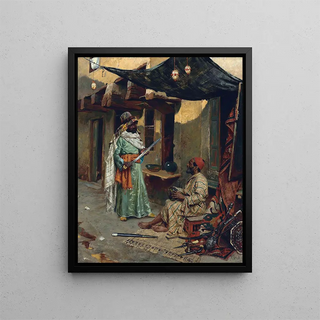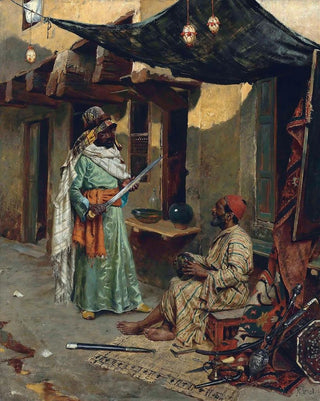Art print | The Arms Dealer - Rudolf Ernst


View from behind

Frame (optional)
Reproduction The Merchant of Arms - Rudolf Ernst – Captivating Introduction
In the painting "The Merchant of Arms," Rudolf Ernst immerses us in a fascinating universe where commerce and art intersect. The piece, rich in narrative detail, depicts a vibrant scene filled with colors and intricate details, where the characters seem to come alive under the artist's virtuoso brushwork. The atmosphere conveyed by this painting transports the viewer to a distant world, where the exchange of precious goods is shrouded in mystery and culture. The depiction of a merchant surrounded by his weapons, with oriental motifs, evokes tales of adventure and exploration, inspiring daydreams and contemplation.
Style and uniqueness of the work
Rudolf Ernst's work is distinguished by its meticulous style and attention to detail. Every element, from the textures of fabrics to the reflections on metals, is rendered with remarkable precision. Ernst excels in the use of light and shadow, creating a depth that breathes life into the scene. The vibrant colors, ranging from deep reds to dazzling golds, add an almost tangible dimension to the artwork. This painting is not merely a simple representation; it tells a story, an interaction between characters that sparks interest and emotion. The composition, both dynamic and balanced, captures the eye and invites exploration of every corner of the image, revealing hidden details upon close observation.
The artist and his influence
Rudolf Ernst, born in 1854 in Vienna, was an artist whose work was deeply influenced by his travels in the Orient. His fascination with exotic cultures is reflected in his paintings, where he manages to capture the essence of these distant regions while translating them through his own artistic lens. Ernst established himself in the 19th-century art scene by blending realistic elements with a certain idealization of the scenes he depicts. His work is marked by a quest for authenticity, but also by a desire for escapism, which allowed him to reach a broad audience. By incorporating historical and cultural elements into his creations, he paved the way for a new appreciation of Orientalist art.

Matte finish

View from behind

Frame (optional)
Reproduction The Merchant of Arms - Rudolf Ernst – Captivating Introduction
In the painting "The Merchant of Arms," Rudolf Ernst immerses us in a fascinating universe where commerce and art intersect. The piece, rich in narrative detail, depicts a vibrant scene filled with colors and intricate details, where the characters seem to come alive under the artist's virtuoso brushwork. The atmosphere conveyed by this painting transports the viewer to a distant world, where the exchange of precious goods is shrouded in mystery and culture. The depiction of a merchant surrounded by his weapons, with oriental motifs, evokes tales of adventure and exploration, inspiring daydreams and contemplation.
Style and uniqueness of the work
Rudolf Ernst's work is distinguished by its meticulous style and attention to detail. Every element, from the textures of fabrics to the reflections on metals, is rendered with remarkable precision. Ernst excels in the use of light and shadow, creating a depth that breathes life into the scene. The vibrant colors, ranging from deep reds to dazzling golds, add an almost tangible dimension to the artwork. This painting is not merely a simple representation; it tells a story, an interaction between characters that sparks interest and emotion. The composition, both dynamic and balanced, captures the eye and invites exploration of every corner of the image, revealing hidden details upon close observation.
The artist and his influence
Rudolf Ernst, born in 1854 in Vienna, was an artist whose work was deeply influenced by his travels in the Orient. His fascination with exotic cultures is reflected in his paintings, where he manages to capture the essence of these distant regions while translating them through his own artistic lens. Ernst established himself in the 19th-century art scene by blending realistic elements with a certain idealization of the scenes he depicts. His work is marked by a quest for authenticity, but also by a desire for escapism, which allowed him to reach a broad audience. By incorporating historical and cultural elements into his creations, he paved the way for a new appreciation of Orientalist art.






